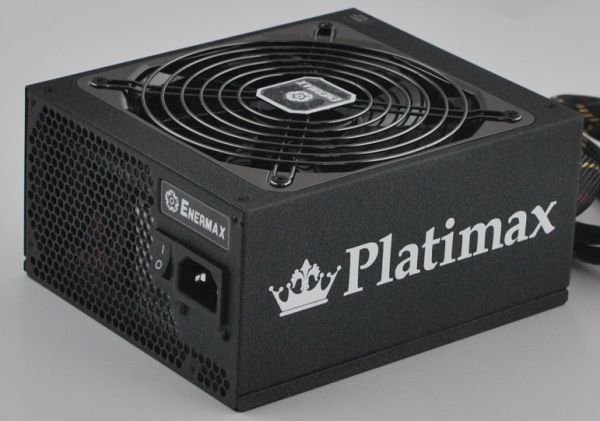Enermax Platimax 750W - 80 Plus Platinum Arrives
by Martin Kaffei on February 10, 2012 6:00 PM EST- Posted in
- Cases/Cooling/PSUs
- PSUs
- 80Plus
- 750W
- Enermax
- 80Plus Platinum
External Impressions and Cable Configuration
The rugged and very thick material is strongly reminiscent of the Revolution85+ series. The color is charcoal gray, with a platinum-like surface around the fan grille. The grille has an Enermax logo in the middle, with a Platimax logo and a picture of a crown on both sides of the power supply. Our personal preference is that more is less when it comes to logos and such, but others might appreciate the markings on the case.
The modular plugs protrude slightly at the front of the PSU. The PCIe plug sockets have a different color than the ones for the peripheral components. The cable sleeving is high-quality, but the gold and red stripes on the sleeves don't quite fit with the 80 Plus Platinum certification. While it's not likely important for many users, there will be some that dislike the Platimax aesthetic.
| Cables and Connectors | ||
|
|
Main | 24-pin 55cm fixed |
| ATX12V/EPS12V |
4+4-pin 60cm fixed 8-pin 60cm fixed |
|
| PCIe |
2x 6/8-pin (50cm) modular 2x 6/8-pin (50cm) modular |
|
| Peripheral |
4x SATA (ca. 45, 60, 75, 90cm) modular 4x SATA (ca. 45, 60, 75, 90cm) modular |
|
|
4x Molex (ca. 45, 60, 75, 90cm) modular 4x Molex, 1x FDD (ca. 45, 60, 75, 90, 105cm) modular |
||
The connector configuration is satisfying. Both CPU cables are very long at 60cm. Each of the two PCIe cables reach 50cm. Altogether the model has four PCIe connectors for graphics cards. The eight SATA connectors are not bad for a 750W power rating. The FDD plug, if you still need one, is at the end of one Molex cable harness. The 24-pin and CPU cables are permanently fixed. Enermax prefers a semi-modular connector system for lower wattages; it's only if you buy the 1000W+ models that you get modular mainboard cables. It's an odd distinction, really—are fully modular PSUs someone more for "enthusiasts" that other 80 Plus Platinum power supplies? Does anyone actually detach their CPU/mainboard cables? Regardless, that's how Enermax has chosen to configure this particular model.
















47 Comments
View All Comments
airmantharp - Friday, February 10, 2012 - link
Did you mean results?Only posted for the humor involved :).
JarredWalton - Saturday, February 11, 2012 - link
There are times when I miss our old CMS system where misspelled words were immediately underlined. Sorry for the error. ;-)Termie - Friday, February 10, 2012 - link
Did I miss it, or did you not actually list the price of the power supply in this article? I would think that would be a critical element of the review. You repeat several times that this is a very expensive power supply, but without a price stated, I don't think your readers will be able to draw any conclusions from this.I know Newegg currently has a paid add running at the top of this article showing its price for this product, but that is not the same thing as stating the price in your article.
JarredWalton - Saturday, February 11, 2012 - link
We linked to the lowest price we could find in the second to last paragraph, but you're right -- nowhere did we actually list the price. I have added that information to the same paragraph now. Thanks!DanNeely - Friday, February 10, 2012 - link
"Does anyone actually detach their CPU/mainboard cables?"2x12V cables is still a relatively high end mobo feature. Being able to get rid of one of these cables would be beneficial for many people.
Also putting jacks on the chassis for cables (GPU3, Peripheral5) only provided in high end models is rather lame in a high end model. A second plug board that leaves the two spaces unsoldered, and without cutouts in the housing shouldn't be prohibitively high as additional engineering work.
Amoro - Friday, February 10, 2012 - link
It looks like it actually failed the requirements for platinum specification at 20% load, achieving only 88.79% instead of the 90% required.Iketh - Friday, February 10, 2012 - link
I was disappointed I didn't learn what a Platinum Certification is in this article. That's the only reason I clicked the article was to get a rundown on the spec itself.Google to the rescue...
Galcobar - Friday, February 10, 2012 - link
Indeed, given the whole article is pitched as being about the arrival of a PSU able to meet the Platinum specifications, I was expecting to be told what the Platinum spec actually meant.As a result, I'm left with another question: did this PSU actually pass the Platinum specs, and at what temperature? Ecos Consulting (the company behind 80 Plus) tests at 23C, actually below the engineering standard room temperature of 25C; lower temperatures make for greater efficiency and slower fan speeds.
JarredWalton - Saturday, February 11, 2012 - link
Thanks for the comments -- I've added a bit of information to the text now.gwolfman - Monday, February 20, 2012 - link
But does this (the certification) have to apply to 120VAC/60Hz? If I remember correctly, 240VAC/50Hz is more efficient to convert to 12VDC, which will take this PSU to new heights.